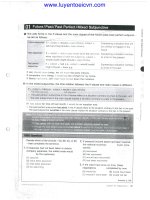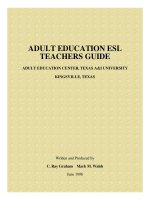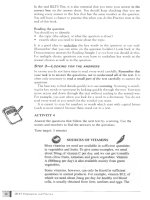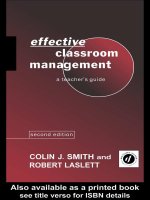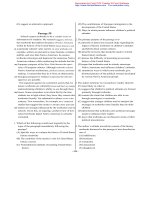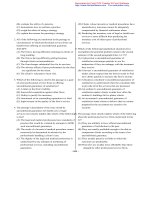Reading sketch 2 teachers guide
Bạn đang xem bản rút gọn của tài liệu. Xem và tải ngay bản đầy đủ của tài liệu tại đây (769.63 KB, 101 trang )
Reading Sketch 2
Teacher's Guide
Build your dreams, Grow as a global leader
www.ibuildandgrow.com
Unit 1|
We Garden Together
Reading Sketch:Teacher’s’sGuide
Unit Objectives: Students will
1. To learn key family member vocabulary
2. To be able to use and understand the expression, “This is my grandfather.”
3. To practice reading comprehension and word recognition
Power Vocabulary:
flower, garden, plant, pull, weed
LESSON GUIDE
Before Reading
Have your students look at the picture. Ask them to describe the picture.
Have the students read the ‘Get Ready’ text together.
Get the students engaged by asking, “What does Sam do?” “What do we do?”
-Have the students listen to each word and point to the word that they hear.
-Then have them repeat each word.
-Have the students take turn reading each word.
-To help the students understand the meaning of the key words, ask “What color
are flowers?” “Where do weeds grow?”
Reading Sketch 2, Unit 1
1
During Reading
Have the students listen as they follow along in their books. Let the students take
turns reading the story out loud.
Have the students try to think back to the story. Ask the students to close their
books (keeping their place with a pencil).
1.
What do I do with Amy?
2.
What do I do with Ray?
3.
What do I do with Jason?
After Reading
Try it!
What is your favorite season? How many flowers can you find in the picture?
Have the students count all the flowers.
Extra Idea:
Ask the students to take out a blank piece of paper. Have them re-draw the story
picture. They should draw their face and their friends’ faces in the garden.
Mini Check Up
1. The kids work in the garden.
2. The girl plants flowers with Jason.
Read each question true or false question. Give the students a moment to think.
Then, Read the question again. Have the students either show an O or X with
their arms.
Reading Comprehension
Have the students complete questions 1-3 based on the reading.
Questions 1&3
Give the students some tips:
Reading Sketch 2, Unit 1
2
Have the students read each possible answer together. Review each answer to
determine whether or not it fits.
Question 2
Have the students scan the story for the word, “weeds.”
Pattern Talk
Have the students read the example sentences in the bubbles. Call on a student
and have them choose one of the words in the idea box to complete the sentence.
Ask the student, “What do you do with your friend?” Then have the student
respond.
Give the students a few moments to work with a partner. Have the pairs practice
taking turns asking each other questions and answering.
Extra Idea:
Have students find their partner. Give each student in the class a sentence strip.
Tell them to keep it secret. Make sure that two students in the class have the
same sentences. Then, have all the students stand up and walk around the
classroom. Have them ask each other, “What do you do with your friend?” Each
student will then respond, (according to their sentence strip) “I _______ with my
friend.” The first three pairs to find each other will get a point!
Word Power
Have the students look at each picture, and check the correct word.
Review the answers by reading the number, and having the students say the
correct answer.
Your Turn
Let the students draw their own garden. Tell them to include anything they would
like to put in it!
Reading Sketch 2, Unit 1
3
ANSWER KEY: STUDENT BOOK
p. 8
Mini Check Up
1. T
2. F
p. 9
Reading Comprehension
1. b
2. c
3. a
p. 10
Word Power
1. flower
2. garden
3. plant
Reading Sketch 2, Unit 1
4
ANSWER KEY: WORKBOOK
p. 2
Word Activity
◎
◎ 1. plant
2. flower
3. garden
4. pull out
p. 3
Writing Practice
2. I pull out weeds with Amy.
3. I water the flower with Jason.
Dictation
garden / weeds / help / plant / flowers / help
Reading Sketch 2, Unit 1
5
Unit 2|
Shapes Everywhere
Reading Sketch:Teacher’s’sGuide
Unit Objectives: Students will
1. To learn shape vocabulary
2. To be able to use and understand the expression,
“There are squares on my blanket.”
3. To practice reading comprehension and word recognition
Power Vocabulary:
circle, heart, square, star, triangle
LESSON GUIDE
Before Reading
Have your students look at the picture. Ask them to describe the picture.
Have the students read the ‘Get Ready’ text together.
Get the students engaged by asking, “What does mom have on her shirt?”
-Have the students listen to each word and point to the word that they hear.
-Then have them repeat each word.
-Have the students take turn reading each word.
-To help the students understand the meaning of the key words, ask “Can you
draw a triangle with your finger?”
Reading Sketch 2, Unit 2
1
During Reading
Have the students listen as they follow along in their books. Have the students
take turns reading the story out loud.
Have the students try to think back to the story. Ask the students to close their
books (keeping their place with a pencil).
1.
What is on my pillow?
2.
What is on my ball?
3.
What is on my blocks?
After Reading
Try it!
How many circles can you find in the picture? Help the students to carefully
distinguish between the shapes. Add up the number of circles in the picture.
Extra Idea:
Create a PPT. Using the animation function, show many shapes (not all the same),
and then take them away quickly. Then ask, “How many ______ did you see?”
The students will then respond, “There are _______ ________.”
Mini Check Up
1. There are triangles on the girl’s pillow.
2. There are circles on the girl’s blocks.
Read each question true or false question. Give the students a moment to think.
Then, Read the question again. Have the students either show an O or X with
their arms.
Reading Comprehension
Have the students complete questions 1-3 based on the reading.
Give the students some tips:
Reading Sketch 2, Unit 2
2
Have the students read each possible answer together. Review each answer to
determine whether or not it fits.
Pattern Talk
Have the students read the example sentences in the bubbles. Call on a student
and have them choose one of the words in the idea box to complete the sentence.
Ask the student, “What shapes are there?” Then have the student respond.
Give the students a few moments to work with a partner. Have the pairs practice
taking turns asking each other questions and answering.
Extra Idea:
Do short scavengers hunt with the students. Have all the students put their heads
down, while the teacher distributes various paper shapes all over the classroom.
Divide the class into five groups: Triangle, Circle, Square, Heart, and Star.
Beginning with one group, give them 20 seconds to try to find all of the their
shapes. Then, count how many they found. Have each group take a turn. The
group that finds the most of their shape will win.
Word Power
Have the students look at each picture, and write in the missing letters. Choose a
few students to spell each shape out loud.
Your Turn
Have the students think of objects that look similar to each shape. Then let them
draw those objects next to the shape that they resemble.
Reading Sketch 2, Unit 2
3
ANSWER KEY: STUDENT BOOK
p. 12
Mini Check Up
1. T
2. F
p. 13
Reading Comprehension
1. c
2. a
3. b
p. 14
Word Power
1. t / r
2. r / c
3. q / r
Reading Sketch 2, Unit 2
4
ANSWER KEY: WORKBOOK
p. 4
Word Activity
◎
◎ 1. square
2. circle
3. triangle
4. star
p. 5
Writing Practice
2. There are stars on my blocks.
3. There are hearts on my clothes.
Dictation
squares / triangles / circles / stars / hearts / shapes
Reading Sketch 2, Unit 2
5
Unit 3|
We Are Friends
Reading Sketch:Teacher’s’sGuide
Unit Objectives: Students will
1. To learn hobby vocabulary
2. To be able to use and understand the expression, “Tim likes to dance. So do I.”
3. To practice reading comprehension and word recognition
Power Vocabulary:
baseball, dance, music, picnic, read
LESSON GUIDE
Before Reading
Have your students look at the picture. Ask them to describe the picture.
Have the students read the ‘Get Ready’ text together.
Get the students engaged by asking, “What does Alice like to do?” “Who else
likes to do those things?”
-Have the students listen to each word and point to the word that they hear.
-Then have them repeat each word.
-Have the students take turn reading each word.
-To help the students understand the meaning of the key words, ask, “Can you
dance?” “Do you like to listen to music?”
Reading Sketch 2, Unit 3
1
During Reading
Have the students listen as they follow along in their books. Let the students take
turns reading the story out loud.
Have the students try to think back to the story. Ask the students to close their
books (keeping their place with a pencil).
1.
What does Tim like to do?
2.
What are we?
After Reading
Try it!
What are the boys doing in the picture? Do you like to do those things? Have the
students look at each picture, and decide if they like doing that activity, or if they
would prefer to do something else.
Extra Idea:
Ask the students to choose a friend in the class. Have the students introduce their
friend by changing the words to the story. Call on a few students; have them
introduce their friend to the class using their edited story.
Mini Check Up
1. Tim likes to listen to music.
2. Tim likes to play soccer.
Read each question true or false question. Give the students a moment to think.
Then, Read the question again. Have the students either show an O or X with
their arms.
Reading Comprehension
Have the students complete questions 1-3 based on the reading.
Give the students some tips:
Have the students read each possible answer together. Review each answer to
determine whether or not it fits.
Reading Sketch 2, Unit 3
2
Pattern Talk
Have the students read the example sentences in the bubbles. Call on a student
and have them choose one of the words in the idea box to complete the sentence.
Ask the student, “I like to go on a picnic?” Then have the student respond.
Give the students a few moments to work with a partner. Have the pairs practice
taking turns asking each other questions and answering.
Extra Idea:
Describe a “friend” in the class. “She likes to dance.” “She is wearing pink.” The
students will try to guess who the friend is. The student who guesses correctly
will then take the teacher’s place. That student will then describe one of their
friends in the class.
Word Power
Have the students look at each picture, and draw a line to the matching word.
Also have them write in the missing letter.
Review the answers by choosing some students to spell each word aloud.
Your Turn
In the three circles, have the students draw some of their hobbies. Choose a few
students to draw their hobbies on the board.
Reading Sketch 2, Unit 3
3
ANSWER KEY: STUDENT BOOK
p. 16
Mini Check Up
1. T
2. F
p. 17
Reading Comprehension
1. a
2. b
3. b
p. 18
Word Power
1. dance
2. read
3. baseball
Reading Sketch 2, Unit 3
4
ANSWER KEY: WORKBOOK
p. 6
Word Activity
◎
◎ 1. music
2. dance
3. baseball
4. picnic
p. 7
Writing Practice
2. Tim likes to play baseball.
3. We are friends.
Dictation
dance / picnic / read / do / baseball / friends
Reading Sketch 2, Unit 3
5
Unit 4|
The Magic Show
Reading Sketch:Teacher’s’sGuide
Unit Objectives: Students will
1. To learn five senses vocabulary
2. To be able to use and understand the expression, “It tastes sweet.”
3. To practice reading comprehension and word recognition
Power Vocabulary:
band, smell, sound, taste, touch
LESSON GUIDE
Before Reading
Have your students look at the picture. Ask them to describe the picture.
Have the students read the ‘Get Ready’ text together.
Get the students engaged by asking, “What do you hear?” “What do you smell?”
-Have the students listen to each word and point to the word that they hear.
-Then have them repeat each word.
-Have the students take turn reading each word.
-To help the students understand the meaning of the key words, ask “What does a
band do?” “What is something that you can taste?”
Reading Sketch 2, Unit 4
1
During Reading
Have the students listen as they follow along in their books. Have the students
take turns reading the story out loud.
Have the students try to think back to the story. Ask the students to close their
books (keeping their place with a pencil).
1.
2.
3.
What feels soft?
What smells delicious?
What am I excited for?
After Reading
Try it!
Touch something around you. How does it feel? Have a few students tell the
class what they feel.
Extra Idea:
Choose a student. Blind fold the student. Have them face the class. Put something
in front of the student; have them feel the object. Let them guess what it is. Give
a few students an opportunity to participate.
Mini Check Up
1. The boy touches the ice cream.
2. The man sells hotdogs.
Read each question true or false question. Give the students a moment to think.
Then, Read the question again. Have the students either show an O or X with
their arms.
Reading Comprehension
Have the students complete questions 1-3 based on the reading.
Questions 1&3
Give the students some tips:
Reading Sketch 2, Unit 4
2
Have the students read each possible answer together. Review each answer to
determine whether or not it fits.
Question 2
Have the students scan the story for the word, “soft.”
Pattern Talk
Have the students read the example sentences in the bubbles. Call on a student
and have them choose one of the words in the idea box to complete the sentence.
Ask the student, “What smells delicious?” Then have the student respond.
Give the students a few moments to work with a partner. Have the pairs practice
taking turns asking each other questions and answering.
Extra Idea:
Create a PPT of several food items. Show each picture, and have the students say
what that food tastes like.
Word Power
Have the students look at each picture, and then re-arrange the letters and write
them in order in the boxes. Choose a few students to write each word on the
board
Your Turn
Review the five senses. Have the students make a list of what they can see, hear,
smell, taste, and touch. Let them work with a partner.
Reading Sketch 2, Unit 4
3
ANSWER KEY: STUDENT BOOK
p. 20
Mini Check Up
1. F
2. T
p. 21
Reading Comprehension
1. c
2. c
3. c
p. 22
Word Power
1. taste
2. hear
3. smell
Reading Sketch 2, Unit 4
4
ANSWER KEY: WORKBOOK
p. 8
Word Activity
◎
◎ 1. touch
2. taste
3. band
4. smell
p. 9
Writing Practice
2. It feels soft.
3. It smells delicious.
Dictation
tastes / touch / soft / smells / sounds / see
Reading Sketch 2, Unit 4
5
Unit 5|
Where Do Animals Live?
Reading Sketch:Teacher’s’sGuide
Unit Objectives: Students will
1. To learn animal habitat vocabulary
2. To be able to use and understand the expression, “Lizards live in the desert.”
3. To practice reading comprehension and word recognition
Power Vocabulary:
desert, land, grassland, river, sea
LESSON GUIDE
Before Reading
Have your students look at the picture. Ask them to describe the picture.
Extra Idea:
Show the students some pictures of animals. Ask the students where they think
that the animals live. Then, discuss each animal’s habitat together.
Have the students read the ‘Get Ready’ text together.
Get the students engaged by asking, “What is it?” “Where does it live?”
-Have the students listen to each word and point to the word that they hear.
-Then have them repeat each word.
-Have the students take turn reading each word.
-To help the students understand the meaning of the key words, ask “What lives
in the desert?” “What animals can you see at the sea?”
Reading Sketch 2, Unit 5
1
During Reading
Have the students listen as they follow along in their books. Let the students take
turns reading the story out loud.
Have the students try to think back to the story. Ask the students to close their
books (keeping their place with a pencil).
1.
Where do lizards live?
2.
Where do horses live?
3.
Where do beavers live?
After Reading
Try it!
How many animals can you find in the pictures? Have the students count the
animals, pointing to each one, and naming it.
Mini Check Up
1. Lizards live in the sea.
2. Horses live in grasslands.
Read each question true or false question. Give the students a moment to think.
Then, Read the question again. Have the students either show an O or X with
their arms.
Reading Comprehension
Have the students complete questions 1-3 based on the reading.
Questions 1&3
Give the students some tips:
Have the students read each possible answer together. Review each answer to
determine whether or not it fits.
Reading Sketch 2, Unit 5
2
Question 2
Have the students scan the story for the word, “forest.”
Pattern Talk
Have the students read the example sentences in the bubbles. Call on a student
and have them choose one of the words in the idea box to complete the sentence.
Ask the student, “Where do owls live?” Then have the student respond.
Give the students a few moments to work with a partner. Have the pairs practice
taking turns asking each other questions and answering.
Extra Idea:
Put the pictures of the animals from the beginning of the lesson on the board.
Choose two students to come to the front of the classroom and turn their back to
the board. Give each student a pointer. The teacher will say, “This animal lives in
a river.” The students will then turn around and put their pointer on the picture of
the animal that lives in that habit as quickly as they can. The fastest student will
earn a point.
Word Power
Have the students look at each picture, and then check the correct habitat. Let the
students check their partner’s answers.
Your Turn
Have the students look at the habitat picture on page 26. Ask them to draw some
animals in their different habitats.
Reading Sketch 2, Unit 5
3
ANSWER KEY: STUDENT BOOK
p. 24
Mini Check Up
1. F
2. T
p. 25
Reading Comprehension
1. c
2. a
3. c
p. 26
Word Power
1. land
2. desert
3. grassland
Reading Sketch 2, Unit 5
4
